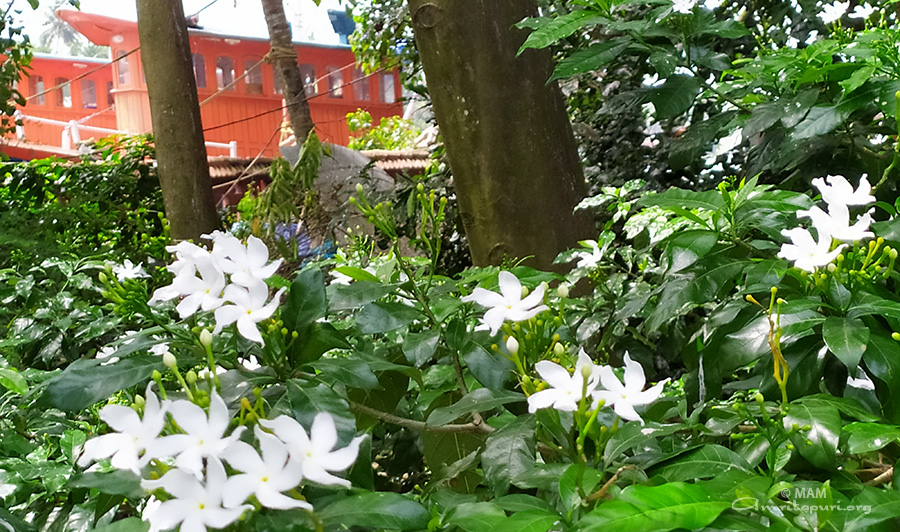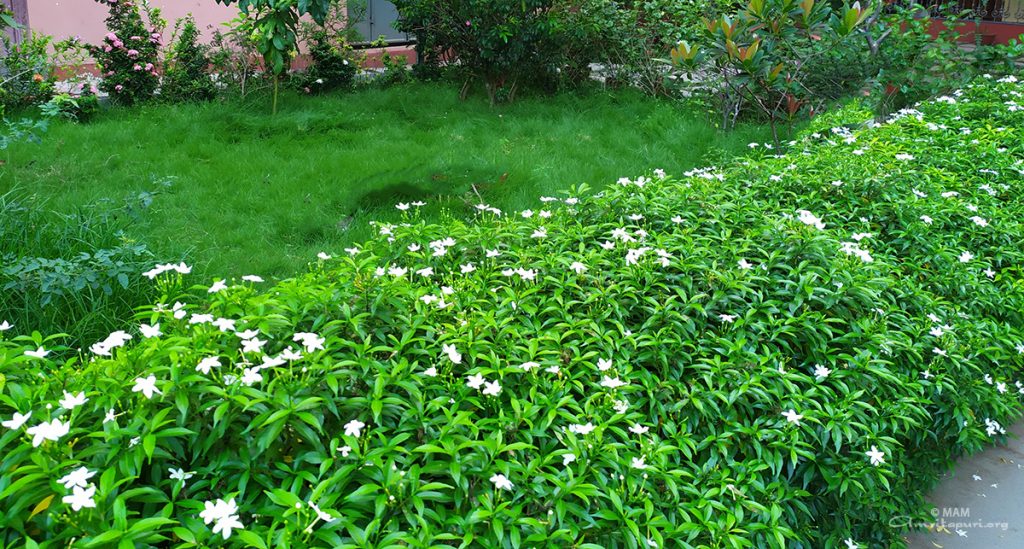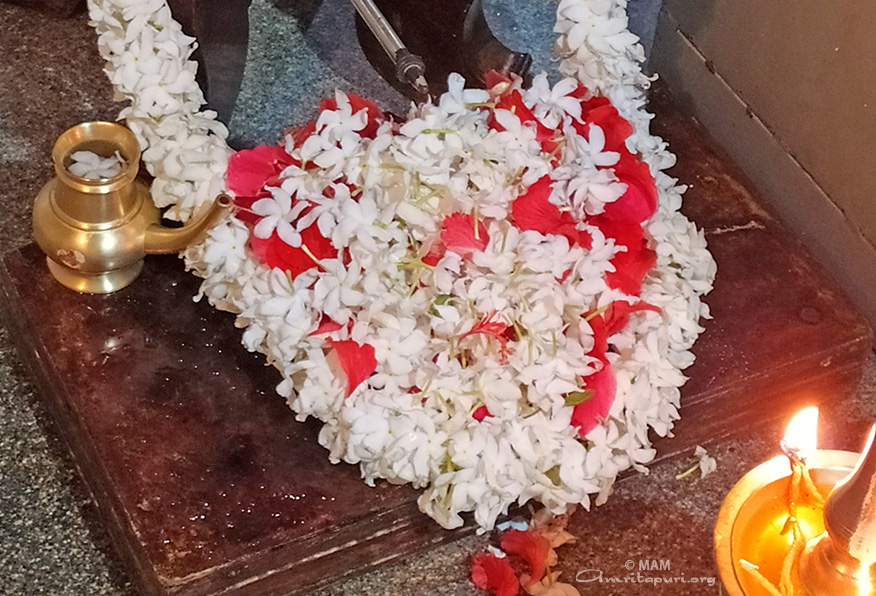Amritapuri – A Bouquet of Flowers II
Panchakshari in Petals: Nandyarvattam

Amritapuri’s beautiful Nandyarvattam white flowers
Flowers are always there in Amma-Lore.
Amma instructs in Manasapuja: “…Imagine a bush without leaves but full of only white flowers… As you chant, with each mantra imagine taking a flower from your heart and offering at the Feet of the Divine…” This helps one develop Ekobhakti, one pointed devotion. In the Shivapurana, Parvati Devi gets Her name Aparna (lit. no leaves) for offering such flowers during her austerities to please Lord Shiva.
“Flowers symbolize our soft feelings. We offer our love to our chosen deity through flower offerings.” “Anything done without Bhavam is like transferring flowers from one basket to another; it won’t become an offering,” Amma often repeats, even while admonishing us for our careless attitude.
On the International Yoga Day drawing the attention of Her world children to the very essential ingredient called Bhavam, Amma said: “We have a special Bhavam (Feeling) when we pluck flowers from vines, or make mala for the deity. We don’t tear at them.” Amma was insisting that we do everything, including Yoga, with the heart’s participation.
Ever since childhood, Amma says She has seen Her grandmother Smt. Madhavi Amma raising flower plants. Those of us in ashram for over two decades may remember Smt. Madhavi amma collecting flowers from different places every day from early morning. She would bring them to Kalari. Even when old and back bent, she sat for hours chanting Mantra and making malas. And whenever she went for Darshan, Amma would jokingly stuff Her ears with flowers, as if responding to Her flower offerings. Amma’s mother Smt. Damayanti Amma also grew flowers, apart from the many trees, so that the family deity is sumptuously offered. Old timers who lived values, saw plants as living beings like oneself; the plants’ life is fulfilled when they bloom, and further uplifted when their flowers reach the deity’s feet.
In changed circumstances of present times, Sadguru Amma elevates the significance of these pious feelings. She would rather have us offer Hridayapushpa– the heart flower. She encourages us to grow plants, but not pluck flowers. “Flowers, even as they are, have already become an offering to the Divine. You don’t need to pluck them out and bring to temple! Flowers are meant for bees and butterflies.” Amma’s vision is always total; all beings however insignificant, are in it.
Among the over 60 white flowers in Amma’s flower basket called Amritapuri, today the star-like Nandyarvattam scores highest.
Today from anywhere in ashram you can see rows of bushes, or at least one bush, with tiny star like flowers as if just fallen from the Sky on Amma’s Bequeath… (ref: Shower of White Flowers of Peace)… as if the white flowers showered from heaven and settled on these bushes…

Around the tree at the entrance of the AD building
As if not to disappoint them Amma allows them into temple worship: they stay on their bushes the entire day, undeterred by rain or shine, and before they fall with nightfall, they are picked for next day Puja. Many senior aged women enthusiastically gather these flowers from all over the ashram, and busy themselves preparing them for next day worship in Kalari. We have at least 5 to 6 varieties of Nandyarvattam the perennial bush with flowers in opulence.

White Purity

A row of Nandyarvattam bushes in one of Amritapuri’s gardens

White blessings from Mother Nature
In traditional old time temples, devotees believe that Devi is pleased by this offering. Of course She who is Full is always pleased. Probably the belief comes from the ancient wisdom: Devi would be pleased because her devotees will have grown the plants, a highly desirable nature friendly activity; She would be pleased many insects get nectar suckling from these simple flowers, and nature is further enriched; She would be pleased that Her devotees will be thinking of the Divine all the time in this enterprise, and move closer to purity of mind; She would be pleased that a human activity thus offered to the Divine makes it Karmayoga; She would be pleased that humans will keep such touching interaction with nature esp. flowers and thus retain innocent joy of a child. For these are the very things Amma is teaching us to learn.

Offered to the Divine
The five definitive Yantra like bold petals bring Panchakshari mantra to mind… as if each petal stands for one of the five letters Na Mah Shi Va Ya- so often heard all over the ashram just as these flowers are seen sprawling all over!
